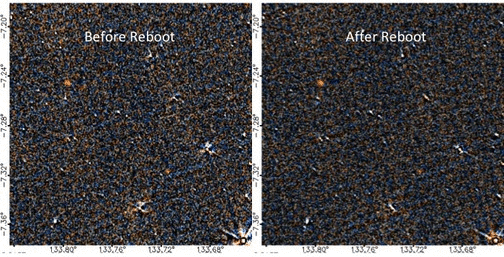Team,
As you may know, the WISE mission has continued to scan the sky during the last few years—collecting more images for us to search. So we’ve started uploading new batches of subjects for you to classify that incorporate new WISE data.
These new subjects are improved in at least four ways:
- They include two entire new years of data, so they cover a 50% longer time span. That means movers move farther and dipoles look brighter.
- The Poisson noise and the amplifier noise (the stripes) are reduced by at least 41%, sometimes by a factor of up to 10 in regions near the ecliptic poles.
- All the images have been realigned, so stationary stars subtract out better. Some of the artifacts and ghosts have been averaged away in the process too.
- Planet 9 and other solar system planets no longer hop and jump. They are simply ordinary dipoles or movers. (If they exist.)
We’ve also taken this opportunity to fix some of the broken links in the metadata and add some handy new ones, like links to WiseView and to WISE images on LegacySurveys. Now, it might not be obvious immediately that you’re looking at a reboot image; they might look at first glance to be just as noisy as the pre-reboot images you’re used to. That’s because we cranked up the gain to match the noise reduction! So they images look just as noisy, but now the objects you’re looking for will be at least 41% brighter. You can always tell you’re looking at a reboot subject if the metadata includes links to WiseView and LegacySurveys and doesn’t say anything about the motion of planet nine.
Now, there’s something important to be aware of when you’re using the reboot data. There are still four frames like you’re used to. But now the biggest time interval is between the first and second frames. Previously, dipoles tended to flip sides between frames 2 and 3. But now, the dipoles will tend to flip between frames 1 and 2. We’ll be updating the tutorials and field guide to illustrate this change (and if you have any nice examples that you think we ought to show, please bring them to our attention).

Unfortunately, each new subject will have its own new TALK page, even if it covers the same region os sky as an older subject. But there will often be a link in the metadata to the old TALK page (if it exists). There will also be links in the metadata to the old TALK pages of the adjacent subtiles, to help you track a dipole or mover that seems to go off the edge of the image.
We will be re-uploading the whole sky bit by bit over the next few months. This is a big project. But we’re starting with a sector that we have not yet looked at before so there there should be some nice new things to discover right away.
Thanks for all the hard work you put in so far—you made it through about 2/3 of the sky once already! Now we’re gonna start fresh and kick it up a notch. Have fun!
Marc Kuchner